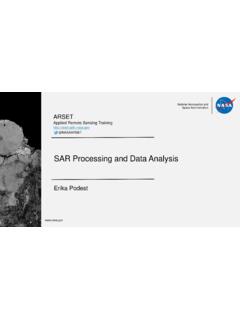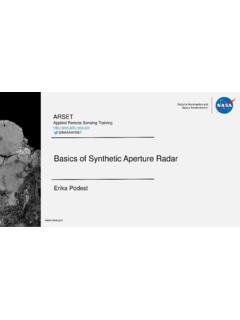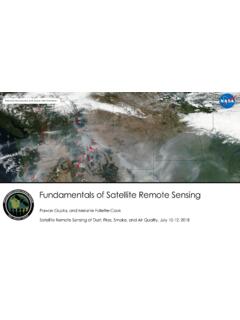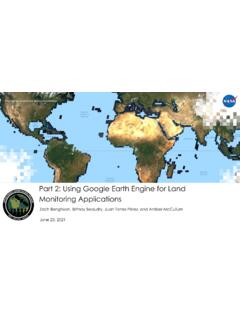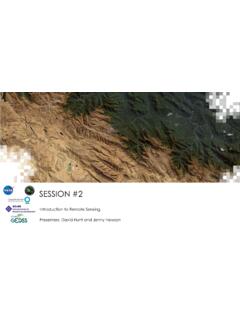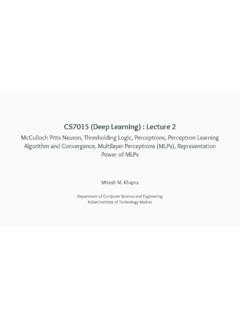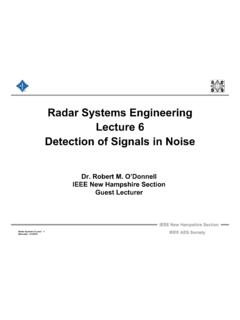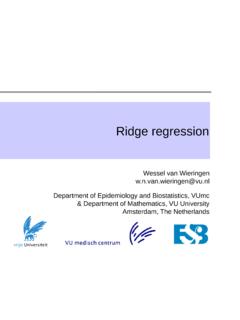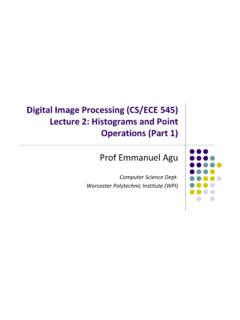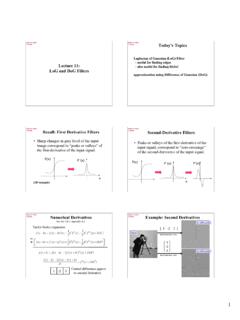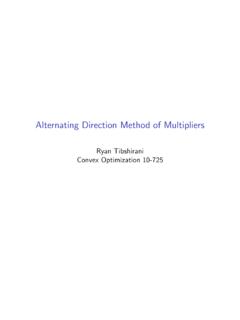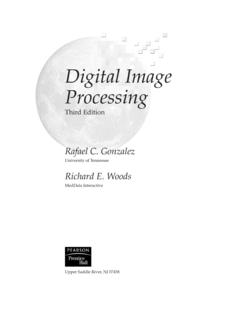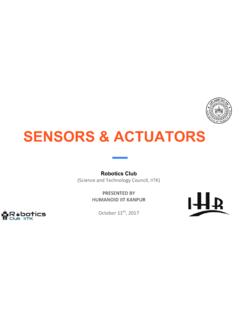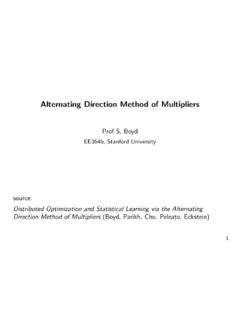Transcription of Part 1: Using Google Earth Engine for Land Monitoring ...
1 National Aeronautics and Space Administration Part 1: Using Google Earth Engine for Land Monitoring Applications Zach Bengtsson, Juan Torres-P rez, and Amber McCullum June 16, 2021. Course Structure and Materials Three 2-hour sessions on June 16, 23, & 30. Sessions will be presented once in English 12:00- 14:00 EDT. Webinar recordings, PowerPoint presentations, and the homework assignment can be found after each session at: mission/training/english/arset- Using -goo gle- Earth - Engine -land- Monitoring -application s Q&A following each lecture and/or by email at: NASA's Applied Remote Sensing Training Program 2. Webinar Agenda Part 1: Google Earth Part 2: Land Cover Part 3: Time Series Analysis Engine Basics & General Classification & Accuracy & Change Detection Applications Assessment NASA's Applied Remote Sensing Training Program 3.
2 Webinar Agenda Part 1: Google Earth Engine Basics & General Applications Zach Bengtsson Juan Torres-P rez Amber McCullum NASA's Applied Remote Sensing Training Program 4. Google Earth Engine Account Reminder Make sure you sign up for a Google Earth Engine account as soon as possible, if you haven't already, Using the link below: #!/. A Gmail address is not required. It is recommended that you use your work/institutional email. NASA's Applied Remote Sensing Training Program 5. Session Outline Introduction to Google Earth Engine (GEE). Advantages of cloud-based raster computing and remote sensing analysis functionalities Available data from land Monitoring satellite sensors Applications of GEE for land management GEE JavaScript API Activity API overview and data catalog search Importing and filtering Landsat 8 data Simple vegetation indices calculation Python API Demonstration Brief review of Python API available for GEE.
3 NASA's Applied Remote Sensing Training Program 6. Introduction to Google Earth Engine Functionalities and Available Data Types Cloud-Based Raster Computing for Remote Sensing Analysis Cloud-based raster computing removes barriers and limitations related to . Data hosting and storage Imagery access and availability Personal computing capabilities GEE is also free for scientists, researchers, and developers. Google Earth Engine code editor interface Using the JavaScript API, displaying Landsat 8 surface reflectance true color imagery for the Credit: Google Earth Engine Developers NASA's Applied Remote Sensing Training Program 8. The Google Earth Engine Platform Google Earth Engine (GEE) takes advantage of cloud computing capabilities to provide users with a single place for accessing satellite data, applying remote sensing methodologies, and displaying analysis results.
4 GEE's application programming interface (API) allows users to easily apply land cover Monitoring algorithms and classifications with coded commands. Image Credit: Google Earth Engine NASA's Applied Remote Sensing Training Program 9. Application Programming Interface (API). The Earth Engine JavaScript API. is currently the most widely used method of working with GEE. A Python API through Google Colaboratory (Colab) is also available for those interested in Using Python. This is a bit more complicated than working directly in the GEE code editor with JavaScript. Google Colab notebook Using a coded section to display elevation in an output cell. Credit: Google Colab NASA's Applied Remote Sensing Training Program 10.
5 Google Earth Engine Functionality Uses of GEE for satellite imagery analysis include: Automation of data processing and display Near real-time Monitoring (limited by the availability of data in the catalog). Machine learning algorithm application Graphical User Interface implementation Simple Classification and Regression Trees (CART) classifier implemented in the GEE API to identify three classes urban, forest, and water in the San Francisco Bay Area for May 2021 Using Landsat 8. imagery. Credit: Google Earth Engine Developers NASA's Applied Remote Sensing Training Program 11. GEE Land Applications Long-term Monitoring of landscape change and land cover type Computation of indices relevant to land management such as normalized difference indices for vegetation, water, snow, soil, and urban areas Landscape time series analysis and change detection Summary statistics Validation and accuracy assessment methods Visualization and presentation of results Time series of MODIS NDVI displayed Using Google Earth Engine .
6 Image Credit: Google Earth Engine Developers NASA's Applied Remote Sensing Training Program 12. Available Satellite Sensor Data in GEE: Landsat Series Data from the entire Landsat series is available for use in GEE, including: Landsat 1-5. Multispectral Sensor Radiance Landsat 4-8. Raw Images Top of Atmosphere Surface Reflectance The full archive includes data from 1972 to present day, with data from 1982 onward at 30m resolution (Landsat 4-8). Available Landsat series GEE Data Catalog Link: collections in the GEE data catalog. Image Credit: Earth Engine Data Catalog Engine /datasets/catalog/landsat NASA's Applied Remote Sensing Training Program 13. Available Satellite Sensor Data in GEE: Sentinel-2. Available Sentinel-2 data includes: Top of Atmosphere Surface Reflectance Sentinel-2 land applications are very similar to those of Landsat, but differences include: 10-20m spatial resolution 5-day revisit Less temporal coverage Available Sentinel-2 data products in GEE.
7 Note the temporal coverage starts in 2015 and GEE Data Catalog Link: 2017. Image Credit: Earth Engine Data Catalog com/ Earth - Engine /datasets/catalog/. sentinel-2. NASA's Applied Remote Sensing Training Program 14. Available Satellite Sensor Data in GEE: MODIS. MODIS reflectance data products include: Daily, 500m Nadir BRDF- Adjusted Reflectance Daily, Global, 250m Surface Reflectance 8-Day, Global, 250m Surface Reflectance Pre-processed products include: Daily, Global, 500m Snow Cover 16-Day, Global, 250m Vegetation Indices False color image of the Terra Surface Reflectance Daily Global 250m projected in the Yearly, Global, 500m Land GEE JavaScript API. Credit: Google Earth Engine Developers Cover Type MODIS GEE Catalog Link: NASA's Applied Remote Sensing Training Program /catalog/modis 15.
8 Available Satellite Sensor Data in GEE: Sentinel-1 SAR. Pre-processed SAR data from Sentinel-1 is available to work with in GEE. Previous ARSET training: Forest Mapping and Monitoring with SAR Data GEE Data Catalog: / Earth - Engine /datasets/catalog/COP. ERNICUS_S1_GRD. A previous ARSET training details the use of SAR data for land management, particularly in vegetated ecosystems. Link: ARSET. NASA's Applied Remote Sensing Training Program 16. Available Satellite Sensor Data in GEE: Land Cover Products A variety of land cover data products are available in GEE, including: Copernicus Global Land Cover Layers MODIS Land Cover Type Yearly Global 500m Global PALSAR-2/PALSAR. Forest/Non-Forest Map USGS National Land Cover Database Copernicus Global Land Cover Layers: CGLS-LC100 collection 3 displayed globally in GEE Data Catalog: GEE.
9 Credit: Earth Engine Data Catalog Earth - Engine /datasets/tags/landcover NASA's Applied Remote Sensing Training Program 17. Applications of GEE for Land Management: Burn Severity Burn severity mapping completed in GEE. manipulates pre-loaded Sentinel-2 or Landsat 8 data and uses the GEE platform as a means to quality control and filter data. Normalized Burn Ratio (NBR) and differenced NBR (dNBR) are calculated. thresholding rates the severity of wildfire burning to complete a full burn severity assessment. Refer to the step-by-step UN-SPIDER burn severity in GEE training Example of burn severity mapping Using Sentinel-2 data in Empedrado, Chile in February 2017. This map was produced Using the UN-SPIDER Burn Severity with GEE.
10 Script. Credit: UN-SPIDER. NASA's Applied Remote Sensing Training Program 18. Applications of GEE for Land Management: Mangrove Mapping ARSET training Using GEE to map mangroves: Remote Sensing for Mangroves in Support of the UN Sustainable Development Goals Random Forest Classification to create a time series for mangrove extent change Creation of apps as management and Example of mangrove extent mapping over a time series to track how communication tools mangrove presence has change over a 20-year period (from the exercises completed during the ARSET Mangrove Mapping series). The previously mentioned ARSET SAR Image Credit: NASA ARSET. training also shows methods of Using Visit the Data Explorer and Comparison Apps SAR data in GEE to map mangroves.
